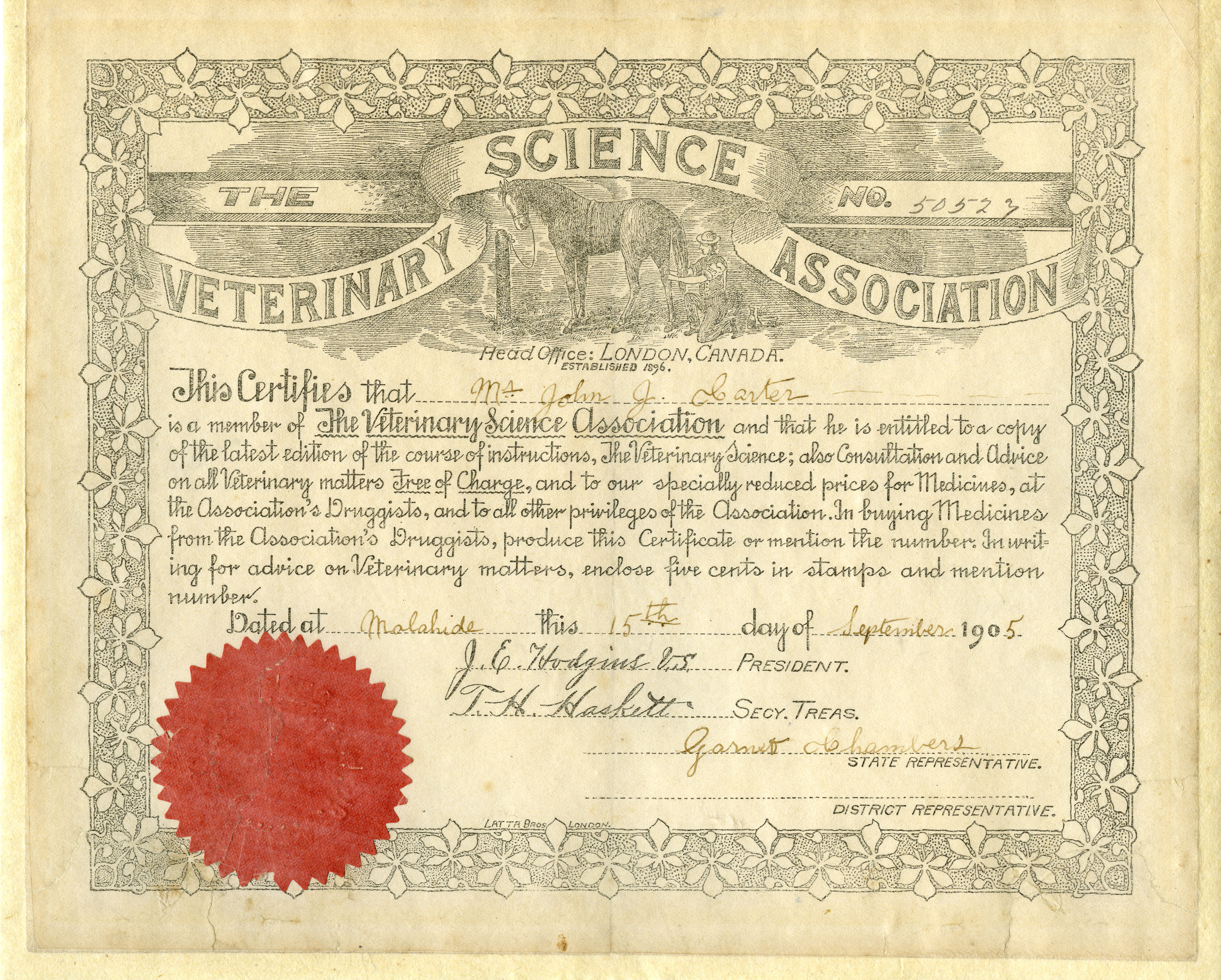Memorabilia
The Rosen collection includes a variety of memorabilia. For example, educational diplomas and certificates from veterinary colleges provide a glimpse into the birth pangs of veterinary medical education in Canada. Business cards and veterinary advertising booklets are discussed in the Veterinary Advertsing section. Andrew Smith and Duncan McEachran, founders of the first two veterinary schools in Canada, brought with them the traditions of the Edinburgh School as they established veterinary education in central Canada. The first continuously operating veterinary school in North America was founded by Andrew Smith in 1862 in Toronto, Canada. The Upper Canada school was renamed Ontario Veterinary College in 1870. The Montreal Veterinary College, a French-speaking college, was established by Duncan McEachran in Quebec, Canada in 1866. The Canadian veterinary colleges, along with the European veterinary schools, supplied trained veterinarians and veterinary educators in North America as the profession was being established outside Europe. For the first decades after the 1870s, many graduates who received their certificates in Canada returned to their own countries to practice, including the United States, where the veterinary educational system was still forming. In Canada, the environment for veterinary education was lively as Smith and McEachran, the principals of the two Canadian colleges, were in competition with each other over philosophical differences in educating their students. Nevertheless, these two men created schools that have evolved successfully with the profession and continue to graduate veterinarians who meet high professional standards. A fuller discussion is found in the Veterinary Education and Professional Organizations sections.
The first class to graduate from the Upper Canada Veterinary School in Toronto in 1866 consisted of three men. The curriculum included: three winter sessions; practice with a qualified veterinary surgeon; and a one-month class on dissection and anatomy. Verbal examinations conducted by faculty, and external medical and veterinary practitioners included the following subjects: anatomy and physiology of the horse and other domestic animals, diseases of the horse, chemistry, and materia medica. Principal Andrew Smith started the Veterinary Medical Society that ran from 1866 to 1902 where students met twice weekly to supplement their studies in veterinary science.The diploma granted by the Board of Agriculture to graduates of the Upper Canada Veterinary School was a signed qualification designed to distinguish it from empirics operating in Upper Canada which offered diplomas in exchange for fees.
For many years the Canadian provincial veterinary associations had to cope with the demands of “graduates who unsuccessfully sought membership and practice privileges.”
From 1896-1921 interested persons could register for a home-study course in veterinary medicine and surgery that was offered through the London Veterinary Correspondence School by the Veterinary Science Company of London, Ontario (Barker, 2013, Canadian Encyclopedia). A diploma and textbook, The Veterinary Science: the Anatomy, Diseases and Treatment of Domestic Animals, found in the Rosen collection indicated to those who completed the correspondence school course that they could practice veterinary medicine. According to Barker (2013, Canadian Encyclopedia), 77 editions of the Veterinary Science text “… were published and diplomas were issued worldwide". For many years the provincial veterinary associations had to cope with the demands of “graduates who unsuccessfully sought membership and practice privileges.”

"From 1896-1921 interested persons could register for a home-study course in veterinary medicine and surgery that was offered through the London Veterinary Correspondence School by the Veterinary Science Company of London, Ontario" (Barker, 2013, Canadian Encyclopedia).

